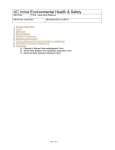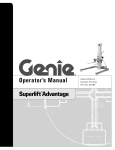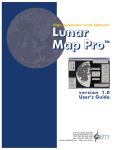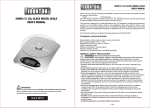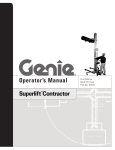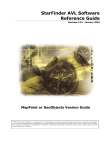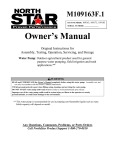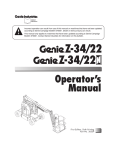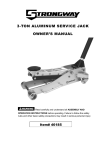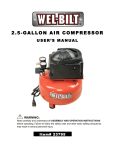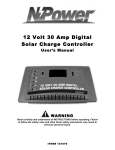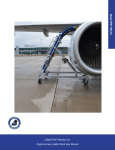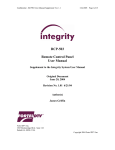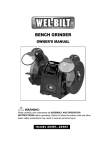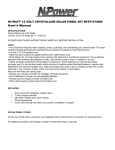Download Manual - Northern Tool + Equipment
Transcript
HAND WINCH STACKER OWNER’S MANUAL WARNING: Read carefully and understand all INSTRUCTIONS before operating. Failure to follow the safety rules and other basic safety precautions may result in serious personal injury. Item # 32849 Thank you very much for choosing an Ironton product! For future reference, please complete the owner’s record below: Model: ______32849_________ Purchase Date: _______________ Save the receipt, warranty and these instructions. It is important that you read the entire manual to become familiar with this product before you begin using it. This machine is designed for certain applications only. The distributor cannot be responsible for issues arising from modification. We strongly recommend this machine not be modified and/or used for any application other than that for which it was designed. If you have any questions relative to a particular application, DO NOT use the machine until you have first contacted the distributor to determine if it can or should be performed on the product. For technical questions please call 1-800-222-5381. GENERAL SAFETY RULES WARNING: Read and understand all instructions. Failure to follow all instructions listed below may result in serious injury. CAUTION: Do not allow persons to operate or assemble this scale until they have read this manual and have developed a thorough understanding of how the scale works. WARNING: The warnings, cautions, and instructions discussed in this instruction manual cannot cover all possible conditions or situations that could occur. It must be understood by the operator that common sense and caution are factors that cannot be built into this product, but must be supplied by the operator. SAVE THESE INSTRUCTIONS WARNING: Failure to follow the instructions and safety rules in this manual may result in serious injury. Do Not Operate Unless: You learn and practice the rules of operation contained in this operator’s manual. 1. Avoid hazardous situations and understand safety rules before going on to the next section. 2. Always perform a pre-operation inspection. 3. Always perform the function tests prior to use. 4. Inspect the workplace. 5. Only use the machine as it was intended. 6. Never use the stacker to lift any person. Fall Hazards Do not use as a personal lifting platform or step. Do not stand or sit on the forks, load platform for boom. Do not climb on the machine. Page 2 of 13 Tip-over Hazards Do not exceed the rated load capacity. See load capacity charts section. Do not raise the load unless the leg hook pins have been properly inserted into the legs. Do not raise the load unless the machine is on a firm, level surface. Do not move the machine with a raised load, except for minor positioning. Do not tilt the machine back with a raised load. Do not use blocks to level the machine. Do not operate the machine in strong or gusty winds. Increasing the load surface area will decrease machine stability in windy conditions. Do not place ladders or scaffolding against any part of the machine. Do not operate the machine unless the wheel/leg/caster configuration is properly installed. Prior to use, check the work area for drop-offs, holes, bumps, debris, unstable or slippery surfaces or other possible hazardous conditions. Avoid debris and uneven surfaces while rolling a machine with the legs not installed. Do not replace machine parts critical to stability or structure with items of different weight or specification. Do not cause a horizontal force or side load to the machine by raising or lowering a fixed or overhanging load. Do not use the machine on a moving or mobile surface or vehicle. Collision Hazards Do not rise if the load is not property centered on the forks or load platform. Check the work area for overhead obstructions or other possible hazards. Do not stand under or allow person under the machine when the load is raised. Do not lower the load unless the area below is clear of person and obstructions. Use common sense and planning when transporting the machine on an incline, or slope. Electrocution Hazards This machine is not electrically insulated and will not provide protection from contact with or proximity to electrical current. Maintain safe distance away from electrical power lines and apparatus in accordance with applicable governmental regulations and the following chart. Page 3 of 13 Minimum Safe Approach Distance Feet Meters Avoid Contact 10 3.1 15 4.6 20 6.1 25 7.6 35 10.7 45 13.7 Voltage Phase to Phase 0 to 300V 300V TO 50KV 50KV TO 200KV 200KV TO 350KV 350KV TO 500KV 500KV TO 750KV 750KV TO 1000KV Allow for mast movement and electrical line sway or sag, and be aware of strong or gusty winds. Keep away from the machine if it contacts energized power lines. Person must not touch or operate the machine until power lines are shut off. Do not use the machine as a ground for welding. SAFETY RULES Do not grasp the cable. Keep hands and fingers away from the pulleys, carriage and other potential pinch points. Improper Use Hazards Never leave a machine unattended with a load. Unauthorized person may attempt to operate the machine without proper instruction, creating an unsafe condition. Damaged Machine Hazards Do not use a damaged or malfunctioning machine. Do not use a machine with a worn, frayed, kinked or damaged cable. Do not use a machine with less than 4 wraps of cable on the winch drum when the carriage is fully lowered. Conduct a thorough pre-operation inspection prior to each use. Be sure that all decals are legible and in place. Maintain proper lubrication on the winch. Do not allow oil or grease braking surfaces. Crushing Hazard Maintain a firm grasp on the winch handle until the brake is locked. The brake is locked when the load will not cause the winch handle to turn. Page 4 of 13 Page 5 of 13 Pre-operation Inspection Be sure that the operator’s manual is complete, legible and available for reference. Be sure that all decals are legible and in place. Check the following components or areas for damage, modifications and improperly installed or missing parts: Page 6 of 13 Winch and related components Base components Legs Roller wheels Inner and cuter frames Glide buttons Carriage hold-down assembly Cable anchor Wheels and casters Forks Load platform and boom (if equipped) Nuts, bolts and other fasteners Cable (kinds, frays, abrasions) Ladder (if equipped) Brake system (if equipped) Check the entire machine for: Dents or damage Corrosion or oxidation Cracks in welds or structural components Be sure that all structural and other critical components are present and all associated fasteners and pins are in place and property lightened. Be sure there is a minimum at 4 wraps of cable around the winch drum when the carriage is fully lowered. Do Not Operate Unless: You learn and practice the principles of safe machine operation contained in this operator’s manual. 1. Avoid hazardous situations 2. Always perform a pre-operation inspection. Know and understand the pre-operation inspection before going on to the next section. 3. Always perform function tests prior to use. 4. Inspect the workplace. 5. Only use the machine as it was intended. Fundamentals The Function Tests are designed to discover any malfunctions before the machine is put into service. The operator must follow the step-by-step instructions to test all machine functions. A malfunctioning machine must never be used. If malfunctions are discovered, the machine must be tagged and removed from service. Repairs to the machine may only be made by a qualified service technician, according to the manufacture’s specifications. After repairs are completed, the operator must perform a pre-operation inspection and function tests again before putting the machine into service. Function Tests 1 Select a test area that is firm, level and free of obstructions. Setup 1 Tilt the machine back. Page 7 of 13 2 Slide each fork onto the carriage and secure it with the fork lock pins. 3 Slide each leg into a base socket until the led lock pin snaps into the leg. 4 Stand the machine up. 5 Remove the winch handle, reverse the handle and install it. The handle grip should face the operator. 6 Straddle base: Adjust to desired width. Be sure the leg lock pin snaps into the leg. 7 Rotate the hold-down bar off of the carriage. Boom 1 Hold the boom n a vertical position. 2 Place the top of the boom plate under the upper fork mounting tube and lift up. 3 Rotate the boom down until it locks into place. 4 Attach the lifting shackle to the desired hole on the boom. Load Platform 1 Lay the load platform onto the forks. 2 Lift the front of the load platform and push it toward the carriage until the back angle is under the lower fork mounting tube. 3 Rotate the load platform down until it locks into place over the forks. Ladder Setup 1 Position the machine 2 Pull the snap pins on both sides of the ladder. 3 Pull the ladder down into the lowered position. Be sure to support the ladder until it is fully lowered. To store the ladder: Raise the ladder to the stowed position and be sure the snap pins lock into place. Test the Brake Operation (if equipped) 1 Press down on the food pedal to lock the brake. 2 Push the machine. Result: The wheels should not roll. 3 Pull up on the foot pedal to release the brake. 4 Push the machine. Result: The machine should move. Test the Winch Operation Note: The model 32849 does not have an inner frame. 1 Rotate the winch handle clockwise to raise the carriage. Result: The carriage should raise to the top of the inner frame and then the inner frame should raise. The carriage and inner frame should move smoothly, free of hesitation and binding. 2 Rotate the winch handle counterclockwise to lower the carriage. Result: The inner frame and the carriage should lower into the outer frame. The carriage and inner frame should move smoothly, free of hesitation and binding Workplace Inspection You learn and practice the principles of safe machine operation contained in this operator’s manual. 1 Avoid hazardous situations. 2 Always perform a pre-operation inspection. 3 Always perform function tests prior to use. 4 Inspect the workplace. Page 8 of 13 Know and understand the workplace inspection before going on to the next section. 5 Only see the machine as it was intended. Fundamentals The workplace Inspection helps the operator determine if the workplace is suitable for sale machine operation. It should be performed by the operator prior to moving the machine to the workplace. It is the operator’s responsibility to read and remember the workplace hazards, then watch for and avoid them while moving, setting up and operating the machine. Be aware of and avoid the following hazardous situations: Drop-offs or holes Bumps and floor obstructions Debris Overhead obstructions and high voltage conductors Hazardous locations Inadequate surface support to withstand all load forces imposed by the machine Wind and weather conditions All other possible unsafe conditions Operating Instructions Do Not Operate Unless: You learn and practice the principles of safe machine operation contained in this operator’s manual. 1 Avoid hazardous situations. 2 Always perform a pre-operation inspection. 3 Always perform function tests prior to use. 4 Inspect the workplace. 5 Only use the machine as it was Intended. Fundamentals Using the machine for any purpose other than lifting material is unsafe. If more than one operator is expected to use a machine at different times in the same work shift, each operator is expected to follow all safely rules and instructions in the operator’s manual. That means every new operator should perform a pre-operation inspection, lunation tests and a workplace inspection before using the machine. Setup Select an area that is firm, level and free of obstructions. Follow the Setup procedures in the Function Tests section. Raising and Lowering Load-Manual Winch 1 Center the load on the forks or load platform. 2 Raise the load by firmly grasping the winch handle and rotating it clockwise. Do not allow the cable to wind unevenly onto the winch drum. 3 Lower the load by firmly grasping the winch handle and rotating it counterclockwise. After lowering to the desired position, turn the winch handle clockwise (raise the load) 1/4 turn to set the brake. Page 9 of 13 Moving Machine with a Load It is best to move the machine on the work site with no load. Moving a raised load should be restricted to positioning for loading and unloading. If it is necessary to move the machine with a raised load, understand and obey the following safety rules: Make sure the area is level and clear of obstructions Make sure the load is centered on the forks or load platform Avoid sudden starts arid stops Travel with the load in the lowest possible position Keep personnel away from the machine and load Do not lift the machine back with a raised load Moving Machine on stairs It is best to move the machine on stairs using the optional stair glides. Moving the machine on stairs without the use to stair glides is not recommended. If it is necessary to move the machine on stairs, understand and obey the following safety rules: Do not move the machine on stairs when the machine is equipped with the 4 point caster option. Fully lower the load. Ease the machine over each stair. Maintain a firm grasp on the handle. Do not allow the machine to become unbalanced. Continue carefully up or down the stairs. Use the appropriate number of people and proper lifting techniques with heavy loads. After Each Use To prepare the machine for storage, remove the forks and legs and reverse the winch handle. Refer to the Setup procedure. Select a safe storage location-firm level surface, weather protected, clear of obstruction and traffic. Transport Instructions Observe and Obey: Be sure the vehicle capacity and loading surfaces are sufficient to support the machine weight. See Specifications section. Do not load the machine onto a vehicle unless it is parked on a level surface. Remove the load from the forks, boom or load platform before loading for transport. The transport vehicle must be secured to prevent rolling while the machine is being loaded. The machine must be securely fastened to the transport vehicle. Lifting Instructions The number of people required to load and a machine is dependent on a number of factors, including but not limited to: the physical condition, strength and disabilities or prior injuries of the people involved the vertical and horizontal distances the machine has to be moved the number of times the machine will be loaded or unloaded the stance, posture and grip used by the people involved the lifting techniques used the site conditions and weather in which the activity is being performed (i.e., slippery, icy, raining) The appropriate number of people and proper lifting techniques must be used to prevent physical injury. Page 10of 13 Loading for Transport 1 Fully lower the carriage 2 Rotate the carriage hold-clown bar over the carriage. Be sure the lock pin snaps into place. Remove the winch handle, reverse the handle and install it. The handle grip should face the carriage. Load Capacity Charts Observe and Obey: Failure to property position the load may result in death or serious injury. Verify that the load you wish to raise does not exceed the maximum load for your load center. See the load capacity charts on the next page. Tip-over hazard: Raising a load that exceeds the machine capacity may result in death or serious injury. A load center is defined as the balancing point (center of gravity)of a load and must be positioned within the load center zone. Tip-over hazard: Failure to position the load center within the load center zone may result in death or serious injury. Forks Load Positioning Instructions 1 Determine the weight of the load and the location of its load center. 2 Measure to the load center from the side of the load that will be closest to the carriage. 3 Refer to the chart on the next page to determine if the machine is capable of lifting the weight at the location on the forks. 4 Place the load so that it rests on the forks, as close to the carriage as possible. 5. Position the load so that the load center is within the load center zone. Inches cm Model 32849 Forks Load Capacity Chart 12 30 lbs kg 500 227 14 35 500 227 Boom Load Positioning Instructions 1 Determine the weight of the load and the location of its load center. 2 Refer to the chart below to determine if the machine is capable of lifting the weight at the location on the boom. 3 Attach the lifting shackle to the desired hole on the boom. Page 11of 13 Maximum Load Centers (measure from front of carriage) Forks: 14 in Load Platform: 14 in Boom: 20 in 35 cm 35 cm 51cm Specifications Page 12of 13 WARRANTY 1-year limited warranty Distributed by Northern Tool + Equipment Co., Inc. Burnsville, Minnesota 55306-6936 NorthernTool.com Made in China Page 13of 13














